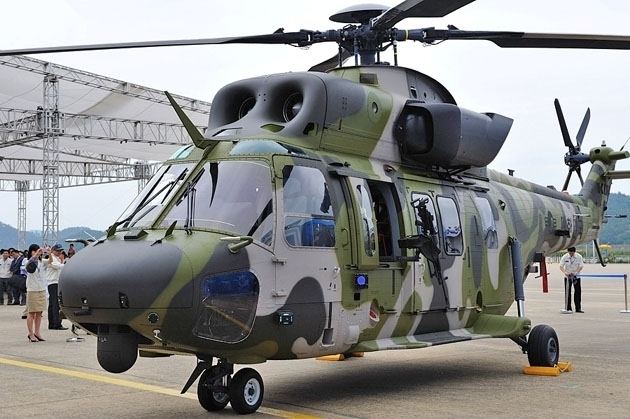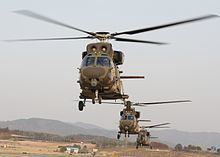Introduced 22 May 2013 | First flight March 10, 2010 | |
Manufacturer | ||
The KAI KUH-1 Surion is a twin-engine, transport utility helicopter developed primarily by Korea Aerospace Industries (KAI), Agency for Defense Development (ADD) and Korea Aerospace Research Institute (KARI) jointly with Eurocopter. In 2006, the research and development phase of the Korea Helicopter Project - Korea Utility Helicopter (KHP-KUH), costing around 1.3 trillion won ($1.2 billion), was launched by the Agency for Defense Development. In 2012, full-scale production of the Surion commenced; KAI has been designated as the principal manufacturer of the type.
Contents
- Kai kuh 1 surion medium transport helicopter
- Origins
- Further development
- Design
- Operational history
- Variants
- Operators
- Specifications
- References

An initial force of around 245 Surions have been ordered by the Republic of Korea Army to replace their aging fleets of UH-1H utility helicopters and 500MD light utility helicopters, which have been in service for decades. KAI shall also construct civilian and law enforcement variants of the helicopter.

Kai kuh 1 surion medium transport helicopter
Origins
In December 2005, the South Korean government appointed Eurocopter as the primary partner to KAI for the then-formative Korea Helicopter Project - Korea Utility Helicopter (KHP-KUH). In June 2006, KAI and Eurocopter won the KHP-KUH 1.3 trillion-won ($1.2 billion) research and development contract from the Defense Acquisition Program Administration (DAPA) to start the project. It remains Seoul's biggest arms deal ever with a non-US company. The development of the aircraft was funded 84% by the South Korean government and 16% by Korea Aerospace Industries (KAI) and Eurocopter. At the time, it was the biggest South Korean defense contract to be issued to a non-American defense company.

A production contract worth about 4.4 trillion won ($4.3 billion) is expected to be signed around 2011 before the start of mass production. Eurocopter took a stake of 30 percent in the 2006-2012 development phase and 20 percent in the following ten-year production phase, KAI and the South Korean government held the remaining stakes in the program. As the prime sub-contractor, Eurocopter has provided technical assistance in part for developing the power transmission, main gearbox, boom and tail gearboxes, automatic flight control system and rotor mast. Eurocopter experts were dispatched to KAI premises (Sacheon, South Korea) to provide support and teach KAI engineers state of the art processes and technologies for the design and manufacture of helicopters.
In June 2008, KAI announced that the first prototype KUH was to be rolled in the following month and that ground tests would begin later that year; the firm also stated that it aimed to conduct the type's first flight in early 2010 and for the first production aircraft to be delivered in 2013. In August 2009, the first prototype was unveiled by President Lee Myung-bak at an unveiling ceremony in Sacheon. In October 2009, it was announced that the program was to be delayed as the result of several ministries having received reduced budgets as greater priority had been placed on social welfare programs; the Ministry of National Defense announced that stability of existing defense programs had been assured.

On 10 March 2010, KAI announced that a prototype had performed the maiden flight of the Surion; two test pilots and an engineer had performed a series of taxiing and hovering maneuvers, as well as a stationary hover at 30 ft (9.1m), during this initial flight. In May 2010, following three months of flight testing, the prototype performed its first public flight demonstration. In January 2011, Eurocopter and KAI established a joint venture, KAI-EC, for the purposes of marketing the Surion and handling export sales; at the time, it was envisioned that 250-300 units would be sold worldwide by 2021. In December 2012, deliveries of the first Surion model formally commenced. In February 2013, low temperature testing in Alaska, United States, was completed, leading to development of the KUH-1 Surion being formally recognized as completed in the following month.
Further development
The KUH-1 Surion served as the basis for a navalised derivative, the Korean Naval Helicopter (KNH). By 2011, the KNH had entered into the development stage; work was being performed on the project by a partnership between KAI, Eurocopter, and Elbit Systems. In January 2016, following completion of development work on the amphibious variant of the Surion, it was announced that this variant had been cleared to enter production later that year.
Various specialised models and derivatives of the KUH-1 have been proposed. In October 2009, KAI revealed that it was studying the potential for developing an indigenous attack helicopter based upon the KUH platform as one available option for meeting an established Korean Army requirement for a new attack helicopter (AH-X). This variant was reportedly to possibly share up to 70 per cent component commonality with the base KUH version. In December 2015, the Korea Forest Service, the largest civil government helicopter operator, ordered a firefighting version of the KUH-1 Surion; this requires a special airworthiness certificate.
In 2014, DAPA's Board of Audit and Inspection begun an investigation into the level of indigenous technology used on the Surion; the investigation revealed that the technology transfer arrangement with Airbus Helicopters only covered 134 out of the 450 components used in the rotorcraft's power delivery system amid allegations of a breach of contract, Airbus Helicopters responded that it had honoured the contractual terms.
In October 2015, KAI announced plans to increase production of the Surion from one helicopter per month to three per month in 2016.
Between 2011 and 2016, the National Aerospace Laboratory of the Netherlands conducted a technology demonstration program under contract from KAI of an experimental fly-by-wire flight control system for the Surion.
KAI is offering the Surion to international markets for military and civilian purposes. In late 2013, it was reported that KAI had received requests for proposals regarding the Surion from two South American nations and another Asian nation; at the time, KAI stated that the company hoped to sell 60-120 over the following 15–20 years. International marketing efforts are expected to escalate in 2017, as prior to this point the overwhelming priority had been to fully develop the Surion to conform with existing domestic requirements and roles. KAI has deliberately focused on marketing the type to countries in which previous export success had been found for the KAI T-50 Golden Eagle and KAI KT-1 Woongbi trainer aircraft.
Design
The KAI KUH-1 Surion is a twin-engine medium-sized multipurpose rotorcraft, carrying up to nine troops along with a crew of four (two pilots and two gunners in the main cabin area) in a utility transport capacity. It has been designed to be rapidly reconfigured to serve different roles, some models are also navalised. The Surion can perform various duties and roles, such as military transport, law enforcement, aerial observation, search and rescue, maritime support, aerial firefighting, and for civilian purposes along with other missions.
Power is provided by a pair of 1,600 shp Hanwha Techwin T700-ST-701K turboshaft engines, a licence-built localized development of the General Electric T700. The T700/701K, co-developed by General Electric and Hanwha Techwin, is the first rear-drive variant of the T700 engine and features a -701D common core, high-efficiency counter-rotating power turbine, and a new FADEC system. The exhausts of the engines are equipped with large infrared suppressors; these have been adapted from those used on the Eurocopter EC725. Airbus Helicopters manufactures various elements of the Surion's transmission; the lower-than-intended level of indigenous production of these components has been a point of controversy.
The Surion is equipped with various survivability and damage reduction features. Both the airframe and the cockpit have been made bulletproof against small arms fire. The airframe, tail rotor, and the rotor blades used on both the main and tail rotors are of a crashworthy construction; anti-explosion sealed fuel tanks are also used. The main gearbox is capable of flying for a limited period after suffering the loss of lubricating oil. Various electronic defensive measures are incorporated onto the Surion, such as a countermeasures dispenser system (CMDS), radar warning receiver (RWR), laser warning receiver (LWR).
British firm Cobham plc provides navigation and communication equipment for the Surion. Sandle Avionic's HeliTAWS multi-hazard avoidance system is installed on Surions in police service. Elbit Systems of Israel produces the helmet mounted display (HMD) used on the Surion, the HMD allows the crew to conduct full day-and-night operations.
Operational history
On 22 May 2013, a handover ceremony of ten Surions was conducted to mark the helicopter's deployment at the Army Aviation School in Nonsan, South Chungcheong Province, attended by President Park Geun-hye.
The KUH-1 performed its first operational mission in August 2015, conducting MEDEVAC in the aftermath of North Korean artillery shells that struck South Korean territory near the Korean Demilitarized Zone. Since entering service, the Surion has reportedly held an availability rate in excess of 80 percent.
The Surion was grounded in July 2016 in response to the CHC Helikopter Service Flight 241. In late 2016, deliveries of the Surion were halted while a resolution for an icing issue that was discovered during winter testing was worked upon.
Variants
The following variants were planned by KAI aside from the manufacture of the Surion.
Operators
Specifications
Data from Militaryfactory.com
General characteristics
Performance
Armament
Avionics
